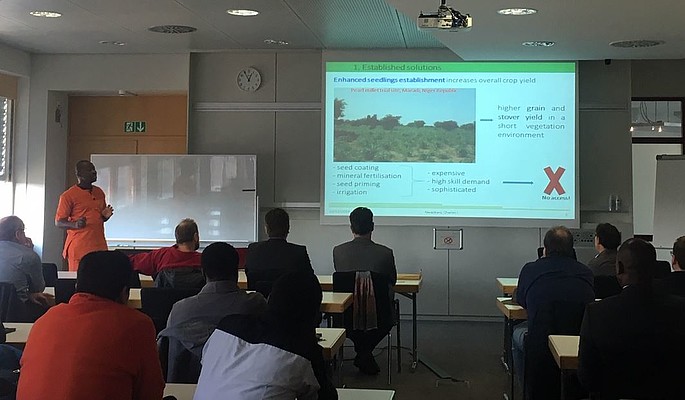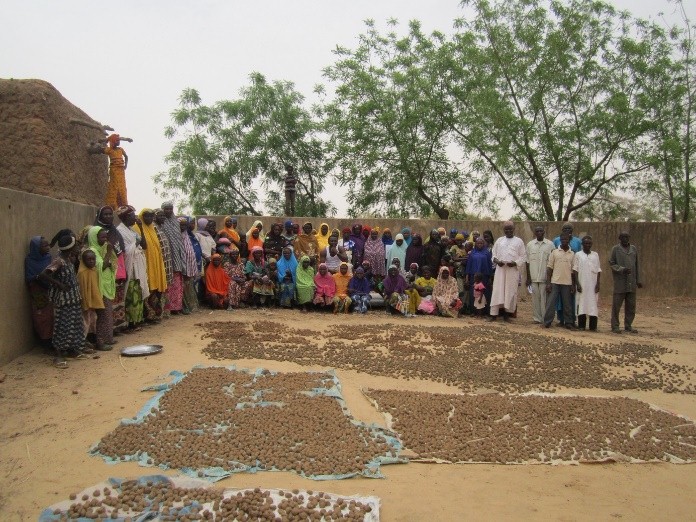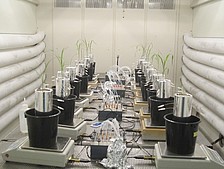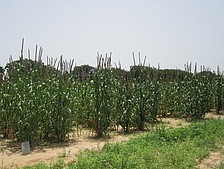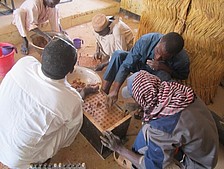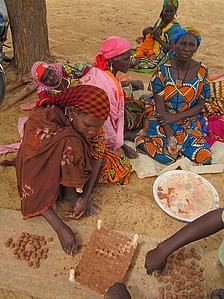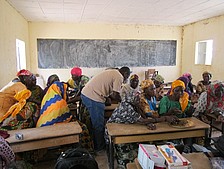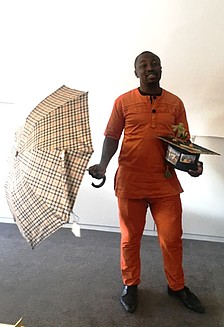Seedball technology development for subsistence-oriented pearl millet production systems in Sahelian West Africa.
Charles Ikenna Nwankwo (PhD Defence 2018)
Institute of Soil Science and Land Evaluation (Soil Chemistry and Pedology 310a), University of Hohenheim, Germany.
Institute of Crop Science (Nutritional Crop Physiology), University of Hohenheim, Germany.
Gaskiya Federation of Madari Farmers Unions (FUMA Gaskiya), Niger Republic.
Institut National de la Recherche Agronomique du Niger (INRAN).
Institut Sénégalais de Recherches Agricoles (ISRA).
Challenges
The yield of pearl millet (Pennisetum glaucum (L.) R. Brown) in the West African Sahel (WAS) is severely restricted by poor seedlings establishment, often arising from the early seasonal drought (Sivakumar, 1988) and low soil fertility (Herrmann et al., 1994). Research has demonstrated that enhanced seedlings establishment is decisive for increased panicle yield of pearl millet under the WAS conditions. E.g., seed coating (Rebafka et al., 1993; Karanam and Vadez, 2010), seed priming (Raj et al., 2004; Aune and Ousman, 2011), micro-dosing (Hayashi et al., 2008; Aune and Ousman, 2011) and irrigation (Singh and Singh, 1995; Fox and Rockström, 2003) can improve seedlings establishment to increase yield under WAS conditions. However, lack of financial resources (Van der Pol and Traore, 1993) as well as skills (Cooper et al., 2008) partly disallow smallholder farmers in particular to use these technologies. Consequently, more than four decades of research findings have not been transferred to the local farmers. As means of adaptation, the farmers practice dry sowing to prolong the vegetative period by crops. But this practice is prone to failure due to erratic rainfall that often occurs at the beginning of the season. When crop establishment fails, re-establishment incurs extra-expenses as well as labour demand.
Therefore, a need for a local material-based innovation, as suggested by Fowler and Rockström (2001) when targeting the smallholder farmers in particular, that can enhance pearl millet seedings establishment is needed.
Again, involving the local farmers as early as possible during the development stage of innovations targeting the African local farmers is crucial for adoption (Herrmann et al., 2013).
Local materials such as wood ash (Augusto et al., 2008), composts (Annabi et al., 2007), as well as termite soil (Mando and Van Rheenen, 1998) can potentially improve crop performance under low nutrient soil conditions as in the WAS. Seedball technology, a local material-based innovation developed by Fukuoka (1978) in the context of permaculture for dry rice farming in particular, may enhance pearl millet dry sowing in the WAS. However, it needs to be physically and chemically optimized in a way that will not hamper pearl millet seedlings germination.
Objectives
The specific objectives of this project are to:
- Review the seedball technology relative to seed treatment options (seed priming and coating), and identify its constraints and applicability in the WAS
- Optimize the seedball technology particulary for pearl millet production in the WAS region using local resources
- Validate its performance under Sahelian field conditions as well as determine its agronomic benefits for smallholder farmers, and
- Strengthen the capacity for seedball research in the WAS.
Achieved results
So far, the seedball technology has
- Improved seedlings establishment through early nutrient supply and reduced crop failures likelihood in the WAS
- Reduced the bottleneck of re-planting at the on-set of farming season
- Increased more female farmers involvement in pearl millet production in Niger Republic, and
- Improved the yield of pearl millet panicle by 30 % in 2016 and 2017 years at the farmers field, in Maradi, Niger Republic.
Aim
The overall aim of the seedball project is to integrate the Nigerien as well as WAS farming systems and significantly contribute to improve and less risky subsistence-oriented pearl millet production.
Method
The first part involved a review, which revealed the potential of the chosen local materials used as the seedball components, followed by several greenhouse experiments that physically and chemically optimized the seedball technology as well as explained the mechanisms behind the seedlings enhancement. In the second part, through several field experiments in the Sahelian fields, the effectiveness of the optimized seedball technology was tested; the agronomic benefits of the seedball technology were assessed. Through the after-harvest interviews, amendments were evaluated and the necessary adaptations for seedball applicability were made. Local tools, seedball machines per se, were developed separately for male and female farmers.
The scientists of INRAN, the workers of a farmer's association (FUMA Gaskiya) and animators were well trained on the importance of seedball, how to produce the seedball, where, when and how to apply the seedball based on the soil type. In addition, through the local radio stations e.g. Binta FM, etc., in Maradi region of Niger Republic, information about the seedball technology were broadcast to the local farmers.
References
Annabi, M., Houot, S., Francou, C., Poitrenaud, M., Bissonnais, Y.L., 2007. Soil aggregate stability improvement with urban composts of different maturities. Soil Sci. Soc. Am. J. 71, 413-423.
Augusto, L., Bakker, M., Meredieu, C., 2008. Wood ash applications to temperate forest ecosystems—potential benefits and drawbacks. Plant Soil 306, 181-198.
Aune, J.B., Ousman, A., 2011. Effect of seed priming and micro-dosing of fertilizer on sorghum and pearl millet in Western Sudan. Exp. Agric. 47, 419-430.
Cooper, P., Dimes, J., Rao, K., Shapiro, B., Shiferaw, B., Twomlow, S., 2008. Coping better with current climatic variability in the rain-fed farming systems of sub-Saharan Africa: An essential first step in adapting to future climate change? Agric., Ecosyst. Environ. 126, 24-35.
Fowler, R., Rockstrom, J., 2001. Conservation tillage for sustainable agriculture: An agrarian revolution gathers momentum in Africa. Soil and Tillage Research 61, 93-108.
Fox, P., Rockström, J., 2003. Supplemental irrigation for dry-spell mitigation of rainfed agriculture in the Sahel. Agric. Water Manage. 61, 29-50.
Fukuoka, M., 1978. The one-straw revolution: An introduction to natural farming. New York Review of Books, New York, United States.
Hayashi, K., Abdoulaye, T., Gerard, B., Bationo, A., 2008. Evaluation of application timing in fertilizer micro-dosing technology on millet production in Niger, West Africa. Nutrient Cycling in Agroecosystems 80, 257-265.
Herrmann, L., Haussmann, B.I.G., van Mourik, T., Traoré, P.S., Oumarou, H.M., Traoré, K., Ouedraogo, M., Naab, J., 2013. Coping with climate variability and change in research for development targeting West Africa: Need for paradigm changes. Science et Changements Planétaires/Sécheresse 24, 294-303.
Herrmann, L., Hebel, A., Stahr, K., 1994. Influence of microvariability in sandy Sahelian soils on millet growth. J. Plant Nutr. Soil Sci. 157, 111-115.
Karanam, P., Vadez, V., 2010. Phosphorus coating on pearl millet seed in low P Alfisol improves plant establishment and increases stover more than seed yield. Exp. Agric. 46, 457-469.
Mando, A., Van Rheenen, T., 1998. Termites and agricultural production in the Sahel: From enemy to friend? NJAS Wageningen Journal of Life Sciences 46, 77-85.
Raj, S.N., Shetty, N.P., Shetty, H.S., 2004. Seed bio-priming with Pseudomonas fluorescens isolates enhances growth of pearl millet plants and induces resistance against downy mildew. Int. J. Pest Manage. 50, 41-48.
Rebafka, F.P., Bationo, A., Marschner, H., 1993. Phosphorus seed coating increases phosphorus uptake, early growth and yield of pearl millet (Pennisetum glaucum (L.) R. Br.) grown on an acid sandy soil in Niger, West Africa. Nutrient Cycling in Agroecosystems 35, 151-160.
Singh, B., Singh, D., 1995. Agronomic and physiological responses of sorghum, maize and pearl millet to irrigation. Field Crops Res. 42, 57-67.
Sivakumar, M., 1988. Predicting rainy season potential from the onset of rains in southern Sahelian and Sudanian climatic zones of West Africa. Agricultural and Forest Meteorology 42, 295-305.
Van der Pol, F., Traore, B., 1993. Soil nutrient depletion by agricultural production in southern Mali. Fertilizer Research 36, 79-90.
Peer reviewed publications:
- Nwankwo, C. I., Mühlena, J., Biegert, K., Butzer, D., Neumann, G., Sy, O., and Herrmann, L., 2018. Physical and chemical optimisation of the seedball technology addressing pearl millet under Sahelian conditions, Journal of Agriculture and Rural Development in the Tropics and Subtropics, 119, 67-79.
- Nwankwo, C.I., Blaser, R.G.A., Vetterlein, D., Neumann, G., Herrmann, L., 2018. Seedball-induced changes of root growth and physicochemical properties – a case study with pearl millet. J. Plant Nutr. Soil Sci., 181, 768-776
- Nwankwo, C.I., Herrmann, L., 2018. Viability of the seedball technology to improve pearl millet seedlings establishment under Sahelian conditions - a review of pre-requisites and environmental conditions. IJAR 6, 261-268
Conference papers:
- Nwankwo, C. I., Herrmann, L., Rennert, T. and Neumann, G. (2015). Optimisation of seedball technology for pearl millet (Pennisetum glaucum) production in the Sahel. Tropentag September 2015, Berlin, Germany
- Nwankwo, C. I., Herrmann, L., Neumann, G. Aminou, A. M., Oumarou, H. M., Nouri, M. K. and Sy, O. (2017). Seedball technology improves pearl millet yield in Sahelian production systems. Tropentag, September 20 - 22, 2017, Bonn, Germany
- Nwankwo, C. I., Maman, N. K., Moussa, H., Sy, O., Maman, A. A., Neumann, G. and Herrmann, L. (2016). Seedball fabrication guide: Harnessing the potential of local materials through seedball technology. Sorghum and Millet Innovation Lab, March 2016, Saly, Senegal
- Nwankwo, C. I., Maman, N. K., Moussa, H., Sy, O., Maman, A. A., Neumann, G. and Herrmann, L. (2016). Mechanisation of seedball production: Increasing pearl millet production efficiency through a simple tool. Sorghum and Millet Innovation Lab, March 2016, Saly, Senegal
- Nwankwo, C. I., Herrmann, L. and Neumann, G. (2017). Assessment of morpho-physiological traits associated with drought stress tolerance in seedball pearl millet seedlings. Sorghum and Millet Innovation Lab, March 2017, Saly, Senegal
- Herrmann, L., Sy, O., Nouri, M., Oumarou, H. M., Aminou, A. and Nwankwo, C. I. (2017). Optimisation of seedball technology for pearl millet; agronomic and socio-economic evaluation in the context of smallholder farmers in Senegal and Niger. Sorghum and Millet Innovation Lab, March 2017, Saly, Senegal
PhD-defence in December 2018.
